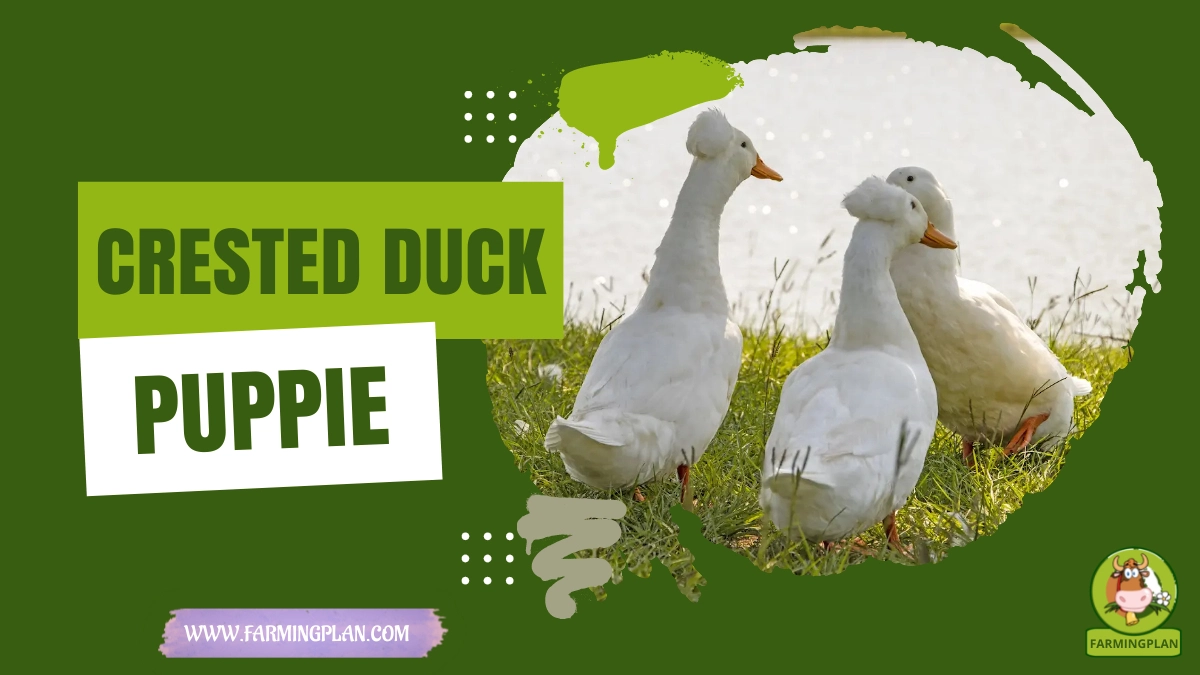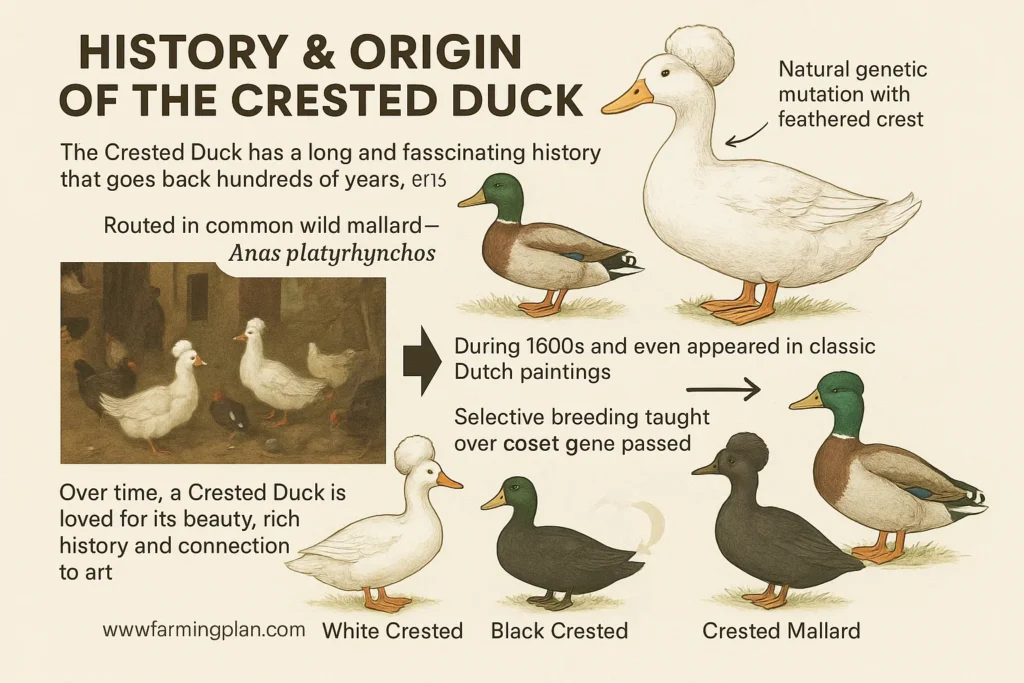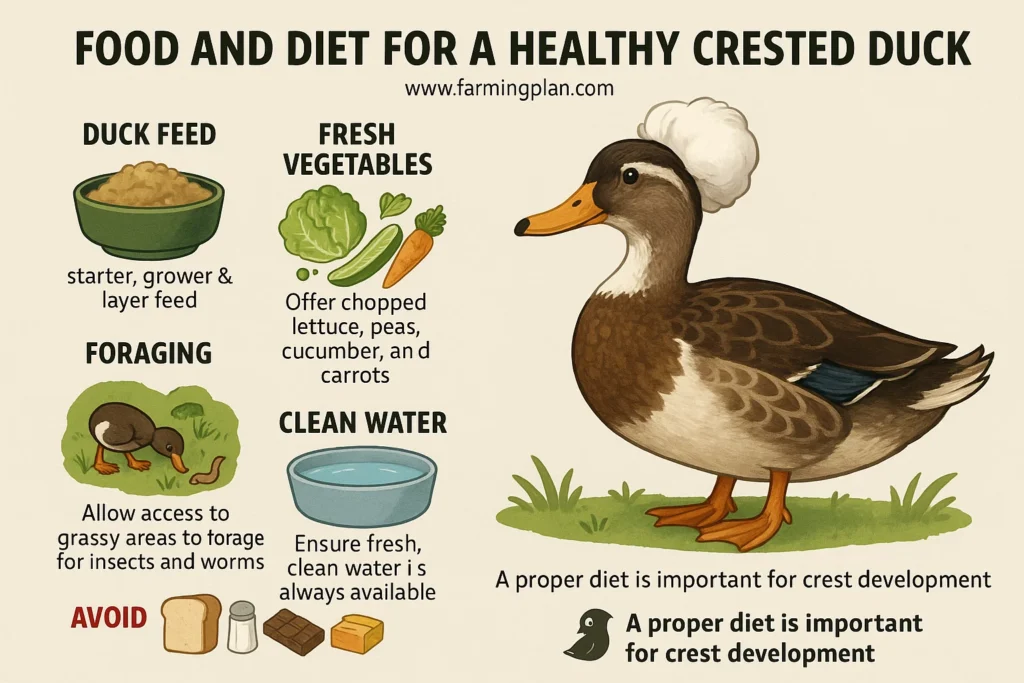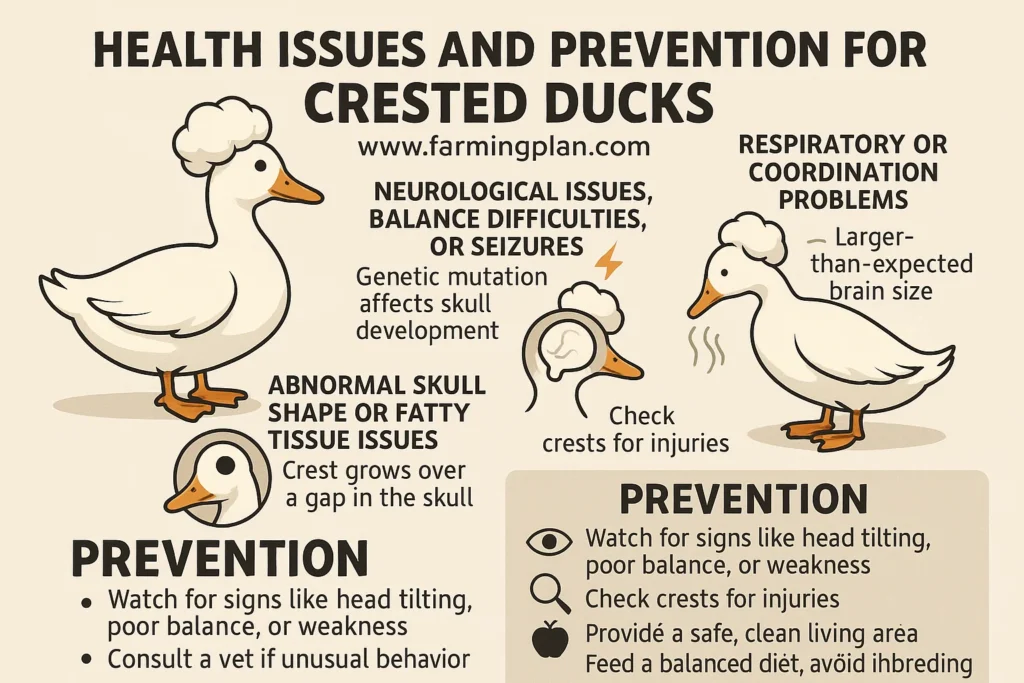The Crested Duck, with its delightful and quirky appearance, is a breed that never fails to intrigue. Its fluffy crest of feathers, resembling a pom-pom atop its head, is not just a fun visual—it’s a result of a natural genetic mutation that affects skull development. This unique trait, giving each duck a one-of-a-kind appearance, is a fascinating aspect of this breed. Whether you’re drawn to the classic White Crested or curious about variations like the Crested Runner or Crested Mallard, this breed brings personality and beauty to any flock.

History & Origin of the Crested Duck
The Crested Duck has a long and fascinating history that goes back hundreds of years. It is believed to have come from Asia or Europe, with roots in the common wild mallard—Anas platyrhynchos. The duck’s unique look comes from a natural genetic mutation that causes a small opening in the skull. This opening allows a puff of fatty tissue and feathers to grow on top of the head, forming the famous feathered crest.

This duck became popular during the 1600s and even appeared in classic Dutch paintings. One of the best-known artists, Jan Steen, included Crested Ducks in his farm scenes, showing how admired they were even back then. Over time, people began to breed them for their unusual and eye-catching appearance. The crest gene is now passed down from one generation to the next, making it a permanent feature in many crested duck breeds.
Today, the Crested Duck is loved not only for its beauty but also for its rich history and connection to art. Whether you choose a White Crested, Black Crested, or Crested Mallard, you’re caring for a duck with deep roots and a rich background. This breed, which became popular during the 1600s and even appeared in classic Dutch paintings, carries with it a sense of heritage and tradition that resonates with many.
Reads More: Dairy Goat Breeds For Milk: Friendly And Productive Choices
Unique Characteristics of the Crested Duck
The Crested Duck is best known for its soft, round crest of feathers sitting proudly on its head. This fluffy crown comes in different sizes, from small tufts to large, bushy crests, depending on the crest gene and how it’s inherited. Some ducks have ideal crests that look perfectly round, while others may have off-center or uneven ones. Either way, these crests give the bird its fun and lovable look.
Crested Ducks come in a variety of colors and types. You’ll find the Crested White Duck, the popular Crested Mallard Duck, and even the beautiful Blue Crested Duck. There’s also the Crested Runner Duck, known for its upright body and long neck, and the Crested Pekin Duck, a plump, friendly breed. No matter the color, most Crested Ducks are medium size, with soft feathers and a calm appearance.
One thing to remember: the crest is more than just cute—it comes from a skull mutation. This mutation can sometimes affect the duck’s balance or coordination, and in some cases, it can lead to health issues such as head injuries or vision problems. However, with proper care and attention, many crested ducklings grow up happy and healthy.
Nature and Temperament of the Crested Duck
The Crested Duck is known for being gentle, curious, and friendly. These ducks enjoy spending time with people and other ducks, making them perfect for backyard flocks or small farms. Whether you choose a white crested duck, a crested black duck, or a more colorful variety, you’ll find that they usually have calm, playful personalities.
They don’t like to be alone and often follow their favorite person around, especially if raised from crested ducklings. They may wag their tails, quack softly, or waddle over for treats. This makes them great for families or anyone who enjoys bonding with their animals.
Crested Ducks are not aggressive. They usually get along well with other duck breeds, chickens, and even gentle pets like rabbits. However, because of the crest on their head, they can be more sensitive to injury. That’s why it’s best to keep them in a safe, calm environment with other peaceful animals. With regular handling and care, Crested Ducks become very tame. Some people even say their ducks respond to their names or come when called.
Food and Diet for a Healthy Crested Duck
Feeding your Crested Duck the right way keeps it healthy, active, and happy. Like most duck breeds, Crested Ducks enjoy a mix of grains, greens, and protein. A balanced diet helps support proper crest development and overall growth. Start with a high-quality duck starter feed for crested ducklings, feeding them three times a day.

As they grow, switch to a grower and then a layer feed for adults, adjusting the feeding frequency to twice a day. These feeds have the right amount of protein, vitamins, and minerals. You can also give them fresh veggies like lettuce, peas, cucumbers, and carrots, but always chop them small to avoid choking. They love foraging, too! Let them roam in grassy areas to snack on bugs, snails, and worms.
This not only helps digestion but also gives them natural nutrients. Clean water is a must—make sure your ducks can dip their heads in it to wash food down and clear their nostrils. Avoid giving bread, salty foods, chocolate, or anything processed. These can cause fatty tissue issues, neurological issues, and respiratory problems over time. A proper diet supports normal development, including their skull and feathered crest.
How Crested Ducks Are Used and Loved
The Crested Duck is a favorite among pet lovers, hobby farmers, and even backyard breeders because of its fun looks and sweet nature. Its main purpose today is companionship. People love to keep them as pets due to their calm behavior and charming crest of feathers. They’re also great for families with kids who want a friendly farm animal that’s easy to care for.
Some small farms and homesteads raise crested duck breeds for egg-laying. A healthy female Crested Duck typically starts laying eggs at around 5-6 months of age. While they don’t lay as many eggs as top egg-producing breeds, a healthy female Crested Duck can still give you a good number of medium-sized white eggs, usually around 100-150 eggs per year. This makes them a fun addition to mixed flocks.
Crested Ducks also appear in shows and fairs. Their unique crests and different color types—like White Crested, Black Crested, and Crested Cayuga Duck—make them popular in bird competitions. However, their skull structure means they’re not ideal for meat production. Their friendly and peaceful nature also makes them great therapy animals in schools or nursing homes. Just watching a Crested Duckling waddle around with its fluffy head can bring joy to anyone!
Special Features That Make the Crested Duck Stand Out
The most famous trait of the Crested Duck is its unique head crest—a fluffy ball of feathers that gives each duck a playful and funny look. This prominent crest grows due to a genetic mutation in the skull that creates a small gap, allowing a soft fatty tissue pocket and feathers to form. No two crests are the same, which makes every Crested Duck feel special!
Crested Ducks come in a wide range of types, such as the Crested White Duck, Crested Black Duck, Crested Mallard, and even the rare Crested Blue Duck. Each breed has its own mix of color, body shape, and crest size. Some have large, rounded crests, while others have smaller or slightly tilted ones. The Crested Runner Duck even walks upright, making it stand out even more.
These ducks are not just beautiful—they’re also smart, alert, and gentle. They bond well with people and other animals and often show playful behaviors like splashing in water or chasing bugs. Their soft feathers, medium size, and sweet nature make them ideal for both beginners and experienced duck keepers.
One more thing: the crest gene is a dominant trait, which means only one parent needs to have it for ducklings to be born with crests. However, not all offspring will have perfectly formed crests. Some may be born with small crests or none at all, depending on how the genes match up.
“Behind Every Fluffy Crest Lies A Quirky Personality And A Whole Lot Of Charm!”
Health Issues and Prevention for Crested Ducks
While the Crested Duck is a charming bird, its unique crest can cause some potential health issues. The same genetic mutation that creates the feathered crest also affects skull development. This can lead to problems like neurological issues, balance difficulties, or even seizures in some ducks.

One common problem is that the crest of feathers grows over a small gap in the skull, which may put pressure on the brain during growth. This can cause abnormal skull shapes or fatty tissue issues. Some crested ducklings are born with a larger-than-expected brain size that can lead to respiratory or coordination problems. To keep your Crested Ducks healthy, watch for signs like head tilting, poor balance, or weakness.
Regularly check their crests for injuries since the feathers and skin can be delicate. Provide a safe, clean living area to avoid infections or injuries. Preventive care includes feeding a balanced diet rich in vitamins and minerals to support normal development and strong immune systems. Avoid inbreeding to reduce the chance of severe genetic defects. If you see any unusual behavior, consult a vet experienced with waterfowl quickly.
Reads More: Amazing American Giant Runt Pigeon: The Ultimate Utility Bird
Step-by-Step Care Guide for Raising Healthy Crested Ducks
Raising Crested Ducks is rewarding and fun when you follow the right steps. Whether you’re a first-time owner or a small farmer, this guide will help your ducks grow healthy and happy.
Prepare a Safe Habitat
Choose a secure, predator-proof area with clean water and enough space for your ducks to roam. Include a shaded shelter to protect them from sun and rain. Make sure the ground is soft to protect their feet and gentle on their crests.
Start with Quality Ducklings
Buy crested ducklings from a trusted breeder or hatchery. Look for active, well-feathered ducklings with well-formed crests. Avoid those with signs of illness or poor balance.
Provide Proper Nutrition
Feed ducklings a starter feed high in protein. As they grow, switch to grower or layer feed. Add fresh greens and small insects for variety. Always provide fresh, clean water for drinking and swimming.
Keep Their Crest Safe
The crest area is delicate. Avoid rough handling and keep their living space free of sharp objects. Check crests regularly for injuries or infections.
Maintain Cleanliness
Clean water and bedding daily. Dirty environments can cause infections or respiratory issues. Provide dry, fresh bedding to keep ducks warm and comfortable.
Monitor Health Closely
Watch for signs of neurological or respiratory problems. Early detection helps prevent serious issues. Have a vet familiar with ducks ready for checkups.
Socialize Your Ducks
Spend time with your ducks daily. Crested Ducks enjoy human company and bond well with their owners.
Expert Tips and Best Practices for Raising Crested Ducks
Caring for Crested Ducks is easier when you know a few expert tips. These tricks help keep your ducks healthy and happy while making your job simpler. First, choose breeding pairs carefully. Because the crest gene can cause health problems, avoid pairing two ducks with very large or uneven crests. This lowers the risk of serious neurological issues in ducklings.
Keep their living space quiet and calm. Loud noises or sudden movements can stress ducks, especially those with delicate crests. A peaceful environment helps them thrive. Use soft bedding like straw or wood shavings. It cushions their feet and protects the crest feathers when they rest. Change bedding often to prevent infections.
Watch for early signs of illness. If a duck seems off balance or has trouble walking, act fast. Consult a vet experienced with waterfowl. Offer plenty of fresh water for swimming. Swimming helps keep their feathers clean and healthy, which is important for maintaining their distinctive crest and smooth plumage.
Where to Buy Healthy Crested Ducks
Finding a reliable source for Crested Ducks is important for getting healthy birds with good crests. Look for reputable breeders who specialize in crested duck breeds or visit well-known hatcheries. Online duck forums and groups often share breeder recommendations. You can find crested pekin ducklings, white crested ducklings, or even rarer types like the crested cayuga duck through trusted sellers.
Local farms and poultry shows are also great places to meet breeders in person. This way, you can see the ducks’ health and crest quality before buying. Make sure the seller provides information about the ducks’ health history and any known issues related to the crest gene. Healthy birds should have clean feathers, bright eyes, and good balance. If you are new to raising Crested Ducks, consider starting with a small group to learn how to care for their special needs properly.
FAQs
What causes the crest on Crested Ducks?
The crest results from a genetic mutation that creates a gap in the skull, allowing fatty tissue and feathers to form a distinctive tuft on the head. This mutation is inherited through the crest gene.
Are Crested Ducks prone to health problems?
Yes, due to the skull mutation, some Crested Ducks may experience neurological or balance issues. Regular health monitoring and careful breeding reduce risks.
How do I care for Crested Ducklings?
Provide a safe, clean environment with balanced feed, fresh water, and gentle handling. Protect their delicate crests by avoiding rough contact and sharp objects.
What do Crested Ducks eat?
They thrive on high-quality duck feed supplemented with fresh greens, insects, and access to clean water. Avoid bread or processed foods that can cause health issues.
Where can I buy healthy Crested Ducks?
Look for reputable breeders online, local farms, or poultry shows. Always check the health and crest quality of the parents before purchasing.
Conclusion
The Crested Duck is a charming and unique bird admired for its distinctive feathered crest and gentle nature. While the genetic mutation behind its crest makes it special, it also requires careful health monitoring due to potential neurological issues. These ducks thrive with balanced nutrition, safe habitats, and gentle care, making them ideal pets or small-farm additions. Whether kept for companionship, eggs, or show, understanding their unique traits and needs helps ensure they live happy, healthy lives. Choosing reputable breeders and following expert care tips can help you enjoy the beauty and personality of this delightful breed.

